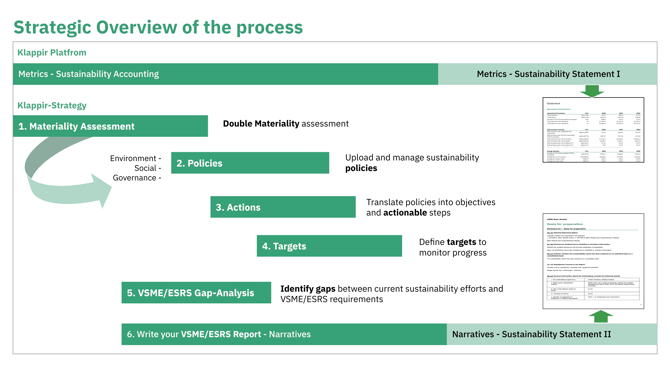Your Sustainability Journey in Klappir-Strategy
Six Core steps from Setup to Reporting
Klappir‑Strategy supports your organisation through a structured sustainability and ESG management journey — from getting started to publishing your report and tracking progress over time.
The journey is organised into six core steps, with guidance before and after to help you stay focused and improve continuously.
Before You Start:
Set Up Your Sustainability Approach. Get familiar with Klappir‑Strategy, define your ESG responsibilities, and clarify your reporting scope.
The Six Core Steps:
-
Assess Relevant Sustainability Topics
Identify the environmental, social, and governance (ESG) topics that are most relevant or applicable to your organisation. -
Document Your ESG Policies
Upload or describe the policies your organisation uses to manage key sustainability and ESG topics. -
Plan Your Objectives and Actions
Define clear objectives and create actions to put your policies into practice — with tasks, deadlines, and responsibilities. -
Set and Track ESG Targets
Establish measurable targets to monitor progress and show how you’re improving over time. -
Evaluate Reporting Readiness (Gap Analysis)
Review the status of each disclosure and identify where information is ready, missing, or not applicable. -
Publish Your Sustainability Report
Export your full sustainability report, including both narrative and data-based content, for internal or external use.
After Reporting:
Monitor Progress and Improve Continuously. Keep track of actions and targets, learn from each cycle, and prepare for your next report with more confidence.

This journey is fully aligned with the VSME Standard for SMEs and the Draft ESRS (European Sustainability Reporting Standards, 30 July 2025) — helping you meet stakeholder expectations and build a credible sustainability foundation.
How This Journey Supports ESG Ratings
If your organisation is evaluated through an ESG rating, supplier assessment, or investor review, Klappir‑Strategy helps you build the structure and documentation they expect. Each step in this journey contributes to a stronger ESG rating — by showing how you manage risks, take action, and report transparently.
You’ll see notes throughout the guide on how each step connects to VSME, ESRS, and common ESG rating frameworks.
Go to the next chapter: